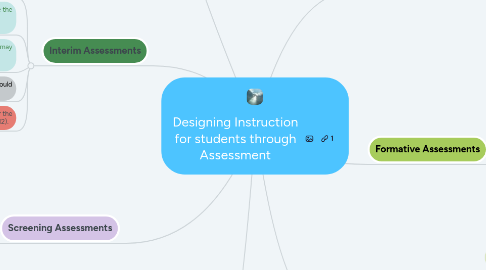Designing Instruction for students through Assessment
by Suz Roskow


1. Screening Assessments
1.1. At the beginning of the year before instruction begins
1.2. Measures students at risk for reading difficulty
1.3. Screening Instruments are economical
1.4. Only examine a few key aspects
1.5. Example of a screening test is a Dibels
1.6. Students are screened in order to determine if more support is needed (Gillet, et.al. 1017).
2. Monitoring Assessments
2.1. Formative Assessments
2.2. Informal Observation
2.2.1. Formal Probe
2.3. Regular Monitoring
2.3.1. Every month
2.3.2. Every quarter
2.4. Testing is done at the end of third grade through eighth grade.
2.5. Monitoring assessments answers in-partitive questions about a students learning.
2.5.1. Has the student made sufficient progress in a subject?
2.5.2. Has the student increased in knowledge in their educational experience?
2.5.3. Provides a comparison between the student and others in the state and country.
2.6. Can be formal or informal assessments.
2.7. These are completed throughout the year (Gillet, et. al. 2017).
3. Interim Assessments
3.1. Evaluate where students are in the learning process.
3.2. Determine if students will have the knowledge to move ahead in further instruction.
3.3. Assessment given in a school year, and may contain Formative and Summative Assessments.
3.4. An example of an Interim Assessment would be a rubric
3.5. Drives data and gives information for the decision making process (Bunch, 2012).
4. Outcome based Assessments
4.1. Grade level based assessment
4.2. Test skills on state standard
4.2.1. Phonics
4.2.2. Fluency
4.2.3. Vocabulary
4.2.4. Comprehension
4.2.5. Phonemic awareness
4.3. Are courses for students relevant
4.4. An examples is, Classroom based opportunities
4.5. Reflects on student progress throughout the year (Gillet, Temple, Temple, & Crawford, 2017).
5. Diagnostic Assessments
5.1. Identify a students precise needs
5.2. Diagnostic assessment adds to screening assessement
5.3. Test specific skills
5.3.1. Comprehension
5.3.2. Inferencing
5.3.3. Reading fluency
5.4. Teachers use to develop a plan
5.5. Diagnostic Decoding Survey is an example of a Diagnostic Assessment.
5.6. Typically given after a screening to meet students needs (Gillet, et. al. 2017).
6. Formative Assessments
6.1. Help teachers identify what exactly students are struggling with.
6.2. Feedback to adjust continual teaching
6.3. Examples of Formative Assessments are student work samples, journals, and projects.
6.4. Response to teachers concerning ongoing learning strategies (Bunch, 2012).
7. Summative Assessments
7.1. Assess student learning at the conclusion of a specific instructional period.
7.1.1. End of the unit
7.1.2. End of a project
7.1.3. A School year
